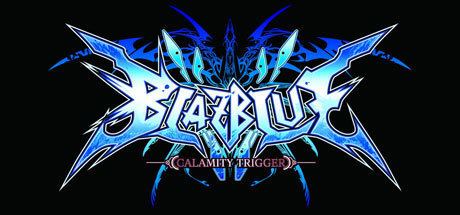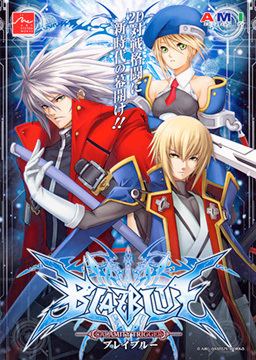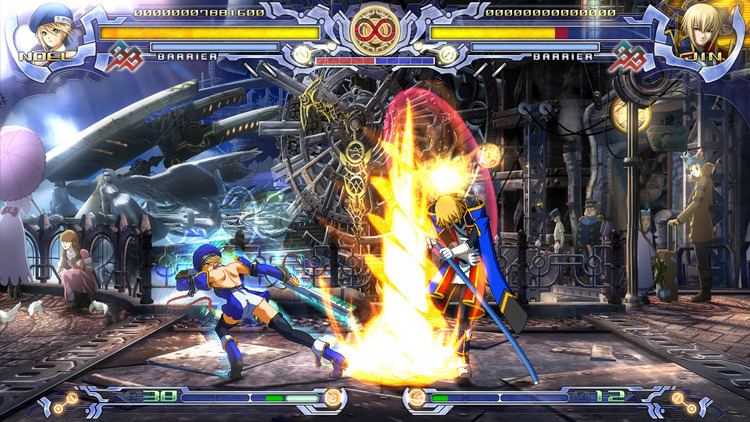8.8 /10 1 Votes8.8
9.4/10 IGN Initial release date 19 November 2008 Genre Fighting game | 9/10 Steam 8/10 GameSpot Arcade system Taito Type X2 | |||||||||||||||||||||||||||||||||
 | ||||||||||||||||||||||||||||||||||
Publisher(s) JP: Arc System WorksNA: Aksys GamesEU: PQube and Zen United Designer(s) Toshimichi MoriYūki Katō Release date(s) ArcadeJP: November 19, 2008NA: November 20, 2008PlayStation 3, Xbox 360JP: June 25, 2009NA: June 30, 2009EU: April 2, 2010PlayStation PortableJP: February 25, 2010NA: March 9, 2010EU: September 9, 2010Microsoft WindowsJP: August 26, 2010EU: August 20, 2010NA: September 02, 2010Windows StoreWW: October 1, 2013SteamWW: February 13, 2014 Similar BlazBlue games, Arc System Works games, Fighting games | ||||||||||||||||||||||||||||||||||
Blazblue calamity trigger story mode part 11 super couch fighters arcade mode
BlazBlue: Calamity Trigger (ブレイブルー カラミティ トリガー, BureiBurū: Karamiti Torigā) is a fighting game developed by Arc System Works in 2008. The game's name is a portmanteau of "blaze" and "blue," with the "z" sound omitted in the Japanese pronunciation, rendering it similar to the word "bray" in pronunciation. Originally released for the arcades, it was also released for the PlayStation 3, Xbox 360 and Windows. A port for the PlayStation Portable, titled BlazBlue Portable (ブレイブルー ポータブル, BureiBurū Pōtaburu), was released in 2010. It was the first title in the BlazBlue game series and extended franchise.
Contents
- Blazblue calamity trigger story mode part 11 super couch fighters arcade mode
- Gameplay
- Advanced Tactics
- Plot
- Characters
- Release
- Console exclusive features
- Reception
- References

Gameplay

BlazBlue is a traditional 2D fighter where two characters participate in a duel. A round is called a "rebel" and one match can consist of one to five "rebels". To win a round, one player must either incapacitate the other by inflicting damage through various attacks to reduce their opponent's health to zero or by having more remaining health than their opponent after the clock runs out.
Every character has a weak, medium and strong attack, as well as an "unique" technique, called a Drive attack, which is different for each character. Those attacks are also known as "A", "B", "C" and "D". Various combos can be performed by every character through careful input of regular and Drive attacks. A combo consists of two or more consecutive attacks that hit an opponent without them retaliating. As combos become longer, each attack will do less damage than normal to give the opponent a chance to retaliate. Grabs can be incorporated into combos also by pressing the "B" and "C" buttons at the same time. Occasionally, some attacks (e.g. Jin's Hirensou) will use portions of the player's heat gauge at the bottom of the screen. The heat gauge is filled by either dealing or receiving damage. When a character has 50% or more heat, special moves called "Distortion Drives" can be performed. When a Distortion Drive is successfully performed and connects with the opponent, it deals massive damage and is visually flashier than normal attacks.
Along with attacks every character has two types of block. One is the regular block that can be broken with a "Guard Crush". That can be achieved by pushing the "Guard Libra" gauge all the way to the opponent's side through repeated attacks. If the opponent keeps blocking, then their guard can be broken, leaving them open for attack. The second type of block is a Barrier Block, which is initiated by blocking while holding the "A" and "B" buttons at the same time. A Barrier Block cannot be broken like a normal guard, but there is a limit on how long one can be held, which is indicated by the Barrier Gauge. If the Barrier Gauge empties, then the player will receive 150% damage until it regenerates to half-full.
Advanced Tactics
A form of an advanced tactic is the "Rapid Cancel". These can be done after any attack to instantly cancel the character sprite's animation frames and reset back to the resting position. However, this can only be done at the cost of 50% of the heat gauge. Counters are one of the easier tactics to perform. All that is required is for a player to strike their opponent while they are in the middle of an attacking animation to stop them in their tracks. This leaves an opponent open for a combo. In addition to a player's regular block options, they can also "Instant Block", blocking as soon as an opponent's attack lands, but reduces the amount of time the character is stuck in their blocking animation and gives you a little heat. If a player is under pressure from the opponent, a "Barrier Burst" can be done at any time to send the opponent away to create some space at the cost of having no Barrier Block and receiving 150% damage for the rest of the round. A Barrier Burst may also be used offensively to break the opponents guard, though the player's character will still suffer the extra damage and be unable to Barrier Block for the remainder of the round. A Barrier Burst can be performed twice at most throughout the entire match.
Plot
Before the events of the game, humanity was on the verge of extinction from a creature called the "Black Beast." The world was saved by six heroes who wielded magic. They helped humanity create "Ars Magus", a fusion of magic and science, to defeat the Black Beast. This event would be later known as the First War of Magic.
After the war, the Novus Orbis Librarium (also referred to as "The Library" or the "NOL") was created to govern the world with the use of Ars Magus. A great deal of dissent was caused by the Library, partly due to Ars Magus' use in nearly every facet of society, and the widening socioeconomic gap between those who could and couldn't use Ars Magus. This dissent would eventually form years later into the Second War of Magic, also known as the Ikaruga Civil War, when the city of Ikaruga openly rebelled against the NOL. Upon winning the war, the NOL imposed a harsher rule on the world, punishing any rebellion against the NOL with death.
In December A.D. 2199, several years after the Second War of Magic, a branch of the NOL was utterly destroyed by an SS-class rebel named Ragna, also known as the "Grim Reaper", in an attempt to destroy the Librarium. The NOL, hoping to stop him, immediately announced the largest bounty ever, available to anyone who could capture him. Interestingly, Ragna possesses a powerful form of Ars Magus known as the Azure Grimoire. This led the NOL, as well as the other fighters, to hunt Ragna not just for his bounty, but also his Azure Grimoire.
Characters
Release
The game was first released for the Taito Type X2 arcade system board, with a 16:9 ratio and 768p resolution, on November 19, in Japan and November 20, 2008 in the United States. It was released on the PlayStation 3 and Xbox 360 home consoles on June 25, 2009 in Japan. A port for the PlayStation Portable, titled BlazBlue Portable, was released in Japan on February 25, 2010, and in Europe on September 9, 2010. The PC version was released in Europe on August 20 and in Japan on August 26, 2010; it is a direct conversion of the Xbox 360 version, and contains cross-platform compatibility via the Games for Windows - Live service. In February 2014, the game was ported to Steam with its Games for Windows - Live features removed and thus the online multiplayer along with it.
The limited edition U.S. version a Blu-ray disc for PS3 or DVD for Xbox 360 comes with a strategy guide and combo videos for every character. Also included is a two-disc Limited Edition soundtrack with special remixes from Oh No. In the European version the two-CD soundtrack is not included, and the tutorial Videos of the PS3 versions are now in DVD format. In the European Limited Edition an artbook is included, containing many drawings and concept art. The same and more pictures can be found in the game's gallery mode.
Console-exclusive features
The PlayStation 3 and Xbox 360 versions includes all content from the arcade version, along with content exclusive to the console versions, including:
Downloadable content for the PlayStation 3 and Xbox 360 versions of BlazBlue: Calamity Trigger included four additional color palettes for each character, four color packs, and a color pack bundle. Unlimited versions of Ragna, Rachel, Hakumen and ν-13 may also be purchased in favor of unlocking them through the game. The Unlimited forms for the other characters are also available for purchase through the Xbox Live Marketplace and PlayStation Network.
On January 14, 2010, Arc System Works announced a downloadable patch for both the Xbox 360 and PS3 versions of the game. This patch is stated to correct several bugs, such as the odd volume glitches regarding Rachel's lightning attacks and "Omae no Tettsui ni Kugi wo Ute!" (the former being occasionally too loud, and the latter suddenly becoming very quiet when Bang is hit during the Fu-Rin-Ka-Zan). It will also update the netcode for smoother online play, and will allow players to join games which are already in progress. It will also allow system updates to be made to the game. To coincide with this patch, a second set of downloadable color packs will be released, as well as the brand-new Unlimited characters from the PSP version.
Reception
The console versions have received positive reviews, with scores of 88% on GameRankings and 89% on Metacritic. Praise has been given for the depth of gameplay in spite of a comparatively small roster as well as an excellent online component. A game's plot has also been surprisingly well-received, many reviews noting it as well-conceived and exceptional amidst the often lackluster and convoluted stories that the fighting game genre has.
Both console versions of the game debuted in the top ten of Japanese sales charts during their week of release. The PlayStation 3 version entered at number five with 34,000 units sold and the Xbox 360 entered at number 6 with 25,000 units sold. In 2009, Blazblue was nominated for a Spike Fighting Game of the Year award but lost to Street Fighter IV.
